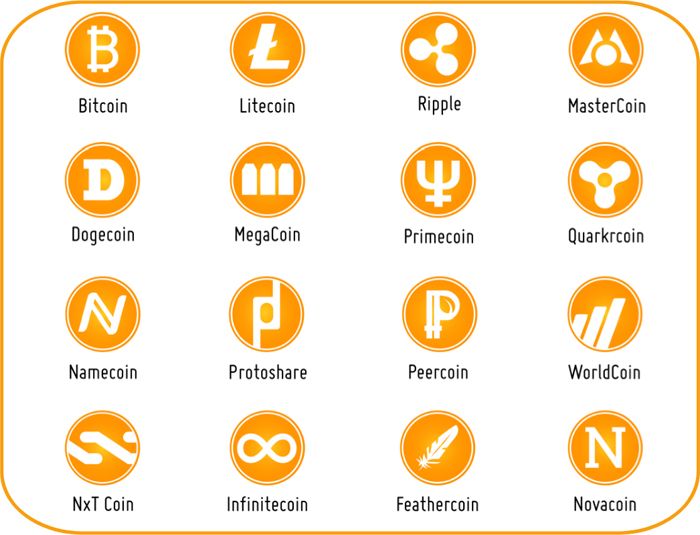types of cryptocurrency trending other than bitcoin

Bitcoin has not just been a trendsetter, ushering in a wave of cryptocurrencies built on decentralized peer-to-peer network, it’s become the de facto standard for cryptocurrencies. The currencies inspired by Bitcoin are collectively called altcoins and have tried to present themselves as modified or improved versions of Bitcoin. While some of these currencies are easier to mine than Bitcoin is, there are tradeoffs, including greater risk brought on by lesser liquidity, acceptance and value retention. Since Bitcoin prices are soaring new highs, we look at six cryptocurrencies, picked from over 700 (in no specific order) that could be worth your while. (Related reading, see: How Do Bitcoin Investors Combat Price Volatility?)
Litecoin (LTC)
Litecoin, launched in the year 2011, was among the initial cryptocurrencies following bitcoin and was often referred to as ‘silver to Bitcoin’s gold.’ It was created by Charlie Lee, a MIT graduate and former Google engineer. Litecoin is based on an open source global payment network that is not controlled by any central authority and uses "scrypt" as a proof of work, which can be decoded with the help of CPUs of consumer grade. Although Litecoin is like Bitcoin in many ways, it has a faster block generation rate and hence offers a faster transaction confirmation. Other than developers, there are a growing number of merchants who accept Litecoin.Ethereum (ETH)
Launched in 2015, Ethereum is a decentralized software platform that enables Smart Contracts and Distributed Applications (ĐApps) to be built and run without any downtime, fraud, control or interference from a third party. During 2014, Ethereum had launched a pre-sale for ether which had received an overwhelming response. The applications on Ethereum are run on its platform-specific cryptographic token, ether. Ether is like a vehicle for moving around on the Ethereum platform, and is sought by mostly developers looking to develop and run applications inside Ethereum. According to Ethereum, it can be used to “codify, decentralize, secure and trade just about anything.” Following the attack on the DAO in 2016, Ethereum was split into Ethereum (ETH) and Ethereum Classic (ETC). Ethereum (ETH) has a market capitalization of $4.46 billion, second after Bitcoin among all cryptocurrencies. (Related reading: The First-Ever Ethereum IRA is a Game-Changer)Zcash (ZEC)
Zcash, a decentralized and open-source cryptocurrency launched in the latter part of 2016, looks promising. “If Bitcoin is like http for money, Zcash is https," is how Zcash defines itself. Zcash offers privacy and selective transparency of transactions. Thus, like https, Zcash claims to provide extra security or privacy where all transactions are recorded and published on a blockchain, but details such as the sender, recipient, and amount remain private. Zcash offers its users the choice of ‘shielded’ transactions, which allow for content to be encrypted using advanced cryptographic technique or zero-knowledge proof construction called a zk-SNARK developed by its team. (Related reading, see: What Is Zcash?)Dash
Dash (originally known as Darkcoin) is a more secretive version of Bitcoin. Dash offers more anonymity as it works on a decentralized mastercode network that makes transactions almost untraceably. Launched in January 2014, Dash experienced an increasing fan following in a short span of time. This cryptocurrency was created and developed by Evan Duffield and can be mined using a CPU or GPU. In March 2015, ‘Darkcoin’ was rebranded to Dash, which stands for Digital Cash and operates under the ticker – DASH. The rebranding didn't change any of its technological features such as Darksend, InstantX. (Related reading, see: Top Alternative Investments for Retirement)Ripple (XRP)
Ripple is a real-time global settlement network that offers instant, certain and low-cost international payments. Ripple “enables banks to settle cross-border payments in real time, with end-to-end transparency, and at lower costs.” Released in 2012, Ripple currency has a market capitalization of $1.26 billion. Ripple’s consensus ledger -- its method of conformation -- doesn’t need mining, a feature that deviates from bitcoin and altcoins. Since Ripple’s structure doesn't require mining, it reduces the usage of computing power, and minimizes network latency. Ripple believes that ‘distributing value is a powerful way to incentivize certain behaviors’ and thus currently plans to distribute XRP primarily “through business development deals, incentives to liquidity providers who offer tighter spreads for payments, and selling XRP to institutional buyers interested in investing in XRP.”Monero (XMR)
Monero is a secure, private and untraceable currency. This open source cryptocurrency was launched in April 2014 and soon spiked great interest among the cryptography community and enthusiasts. The development of this cryptocurrency is completely donation-based and community-driven. Monero has been launched with a strong focus on decentralization and scalability, and enables complete privacy by using a special technique called ‘ring signatures.’ With this technique, there appears a group of cryptographic signatures including at least one real participant – but since they all appear valid, the real one cannot be isolated.
The Bottom Line
Bitcoin continues to lead the pack of cryptocurrencies, in terms of market capitalization, user base and popularity. Nevertheless, virtual currencies such as Ethereum and Ripple which are being used more for enterprise solutions are becoming popular, while some altcoins are being endorsed for superior or advanced features vis-à-vis Bitcoins. Going by the current trend, cryptocurrencies are here to stay but how many of them will emerge leaders amid the growing competition within the space will only be revealed with time.